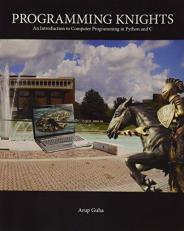
C knights an introduction to programming in c pdf code#
Write a C procedure decode ( ) that decodes such a code in int code, using the coding tree in Figure 8.5a, putting the ASCII string back as it was in char string.ĩ. To convert the ASCII string to Huffman code, asĭefined by the coding tree in Figure 8.5a, storing the code as a bit string, first bit as most significant bit of first element of int code. Void Cstack::pushĪ global object of a class is declared and then used as shown below: The compiler could generate the assembly-language program or the machine code produced by this program.Ī class's function members are written rather like C procedures with the return type and class name in front of two colons and the function member name. Each high-level language statement is designed to express an idea used in the statement of the problem and is oriented to the user rather than the machine. Each line of the program generates many machine instructions or lines of assembly-language code. Consider the dot product subroutine used in the previous chapter, written in C below. Second, a high-level language is designed to be oriented to the specification of the problem that is to be solved by the program and to the human thought process, while a program in an assembly language is oriented to the computer instruction set and to the hardware used to execute the program.

First, a line of a high-level language statement will often generate five to a few tens of machine instructions, whereas an assembly-language statement will usually generate (at most) one machine instruction. A high-level language is different from an assembly language in two ways. A compiler is a program that converts a sequence of (ASCII) characters that are written in a high-level language into machine code or into assembly language that can be converted into machine code. We first discuss the difference between an assembler and a compiler. We give an example of a program that uses many of the features we need in the next chapter, and then discuss C++ and object-oriented programming. We then begin with a description of C, illustrating first operators and statements and then conditional and loop expressions. The first section provides terminology and understanding of where to use high-level language compilers and interpreters. However, if you have already covered this material, it can be skipped. Together, they illustrate what a programmer is doing when he or she writes high-level language programs. Trust AN INTRODUCTION TO PROGRAMMING WITH C++, 8E to keep you enthusiastic about learning as you master the skills of C++.This chapter gives background material for Chapter 9, which shows how C or C++ statements are encoded in assembly language. All example programs in this book are written in C++, and the standard library's data. The purpose of this book is to give you a thorough introduction to competitive programming. Programming in C is all about.What better way to gain an appreciation for this language than by taking a look at an actual program written in C? 19.4 Knight's tours. Memorable new examples portray concepts in action, while abundant new hands-on exercises, including mini-quizzes, Labs, and “Try This” features, guide you in absorbing, practicing, and applying concepts as you progress.Ĭhapter 19, “Object-Oriented Programming,” gives a brief introduction to OOP and some of its.

This unique text incorporates a student-focused approach that continually highlights the importance and relevance of the programming concepts you are learning.

This book’s distinctive emphasis clarifies how mastering C++ programming skills will benefit you now and throughout your career. Trust AN INTRODUCTION TO PROGRAMMING WITH C++, 8E to keep you enthusiastic about learning as you master the skills of C++.īook Description: Discover the importance of learning C++ with Diane Zak’s popular AN INTRODUCTION TO PROGRAMMING WITH C++, 8E. Memorable new examples portray concepts in action, while abundant new hands-on exercises, including mini-quizzes, Labs, and 'Try This' features, guide you in absorbing, practicing, and applying concepts as you progress. This book's distinctive emphasis clarifies how mastering C++ programming skills will benefit you now and throughout your career. Ebook Description Discover the importance of learning C++ with Diane Zak's popular AN INTRODUCTION TO PROGRAMMING WITH C++, 8E.


 0 kommentar(er)
0 kommentar(er)
